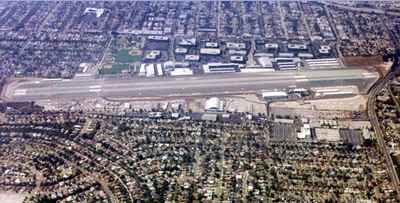Airport Manager Explains Landing Fees, Philosophy, and
Balancing Act
 Bob Trimborn, the Airport Manager for Santa
Monica (CA), was looking at ANN yesterday, when he called us in
answer to our interview request, a counterpoint to the NBAA's attempts to stop
soon-to-be-imposed landing fees. "We're rabidly pro-aviation," we
warned him; he replied, "...and so am I."
Bob Trimborn, the Airport Manager for Santa
Monica (CA), was looking at ANN yesterday, when he called us in
answer to our interview request, a counterpoint to the NBAA's attempts to stop
soon-to-be-imposed landing fees. "We're rabidly pro-aviation," we
warned him; he replied, "...and so am I."
Trimborn, in fact, has been flying since he was a kid. His
current job often puts him in conflict with various individuals and
groups, he acknowledged; but his concern, he told us, is for
aviation, and his community's aviation safety.
He explained how things came about at his hometown airport: "We
are a unique airport in that we have the 1984 settlement agreement
with the FAA, that said the airport would stop receiving funds in
1995." There's a lot to do there. "We have 200 acres of pavement."
That pavement -- runways, ramps, parking, apron areas -- takes a
lot of maintenance, and Trimborn and the Board wanted to figure out
an equitable way to pay for the inescapable maintenance. "In 2000,
[consulting firm] PCI did a comprehensive pavement maintenance
program, and calculated costs per year to maintain the airport."
Part of that algorithm included assessing the potential damage
various-sized aircraft could do to the pavement. "They calculated
the 'damage coefficient' of various aircraft. It's akin to truck
fees, etc. -- the 'damage coefficient' trucks do to highways or
access roads -- then we applied it to the landing fees. It's a
weight-based landing fee. That's why a 10,000 pound jet pays a lot
less than a 60,000 pound jet."

Somebody has to pay for the maintenance, Mr. Trimborn said; and
a fair way to allocate the costs would have to include the 'damage
coefficient.' A heavy airplane can do a disproportionate amount of
damage -- damage isn't linear with weight, in other words. [One of
those, "ten thousand butterflies' landings don't do the same thing
as a bowling ball drop" things --ed.]
"Up until 1995, the airport was funded through AIP grants from
the FAA. That grant played itself out two years or so ago. When
that ended, we needed to rapidly find a funding source," he
noted.
"The who airport is supported by user fees -- the airport does
not use general fund monies -- it's self-sufficient in that
regard... That's what NBAA ignores," the manager said. "We're using
these fees to pay for maintenance."
There's another, distinct issue, too, though: safety.
 Bob continued, trying to
bring us closer to a more-general understanding of the balancing
act he does on a daily basis. "There are two different issues here.
One is, we're trying to maintain runways and pavement; the other is
safeguarding lives and property. This [landing fee schedule] is not
a 'disguised jet ban.'" He explained that it would be easier to ban
the smaller, older jets, due to noise; he doesn't want to do that,
either: "The smaller jets, in general, have louder engines. This
[current action] has nothing to do with noise -- our issue here is
safety."
Bob continued, trying to
bring us closer to a more-general understanding of the balancing
act he does on a daily basis. "There are two different issues here.
One is, we're trying to maintain runways and pavement; the other is
safeguarding lives and property. This [landing fee schedule] is not
a 'disguised jet ban.'" He explained that it would be easier to ban
the smaller, older jets, due to noise; he doesn't want to do that,
either: "The smaller jets, in general, have louder engines. This
[current action] has nothing to do with noise -- our issue here is
safety."
Trimborn isn't happy with what he sees as an FAA 'double
standard' regarding the way scheduled and GA flights are handled,
even if the aircraft are identical. "If you have a Part 139
airport, the FAA requires compliance with airport conformance; they
don't require that for GA," he noted. We mentioned that may be
because the idea of flying to a schedule can be very different from
flying to a destination. He countered, "...but if the Chairman of
[a company] wants to get here at a certain time, do you really
think the strain on the corporate pilot is all that different?"
Trimborn wanted to slow the expansion of larger jet use,
invoking provisions in the Aircraft Conformance rules, rules that
were written long after the airport was established. Rules that,
were a new airport contemplated, the planners would have to follow.
"As soon as we started talking about Aircraft Conformance," he
said, "the FAA moved against us in a Part 16 operation. They
haven't come to me to tell us what we should do -- just what we
can't do."
That led to another topic: the bigger planes.
"There's no way to build a safety area at the end of the
runway," he told us, noting that, under current design rules, there
should be 1000 feet of space there; there's just a couple hundred,
depending on which end of the runway you're looking at. Then
there's houses. "All the city is saying," he tried to explain, "is
that the airport is built for a certain class of airplane -- a B-II
class airplane. The airport can accommodate a class B airplane. Not
C and D."
"Are you trying to ban Class C and D aircraft?"
we asked.
"That's exactly what we're trying to do," he answered, "but for
safety reasons."
How did the area get so built up?
 Santa Monica is an old airport,
starting just after WW I, as a training base for the Army Air
Corps. "We were sited in 1919," Bob said. "We're one of the oldest
airports in California. The Army Air Corps found this nice flat
piece of land -- they flew the Jennys here. Then Donald Douglas
showed up -- and the rest is history." Douglas built his factory
there, and flew everything through DC-7s out of Santa Monica...
Santa Monica is an old airport,
starting just after WW I, as a training base for the Army Air
Corps. "We were sited in 1919," Bob said. "We're one of the oldest
airports in California. The Army Air Corps found this nice flat
piece of land -- they flew the Jennys here. Then Donald Douglas
showed up -- and the rest is history." Douglas built his factory
there, and flew everything through DC-7s out of Santa Monica...
"The Douglas World Cruisers [the first planes to fly around the
world] started here, in 1924 -- and 100,000 people were here for
the sendoff to Portland," Bob told us. "The event [the official
start of the circumnavigation was in Oregon --ed.] really started
here, and ended here. It's what put Douglas in 'superstar'
position."
So, how did the area get so built-up?
"The sins of the father," he replied. "The people who used to
work at Douglas -- they lived here; they wanted to work near where
they lived, near LA and Santa Monica."
Zoning boards did what they always seem to do: they allowed
building right up to the airport property line. now, the people who
bought those homes -- many built in the 1940s and -50s -- are
discovering that they're living under, or nearly under, a flight
path.
He'd like a little understanding: "This issue will go on; each
airport is different -- this isn't Burbank or Van Nuys, or anywhere
else. Look -- I'm a pilot -- I've flown since I was 14; and I'm
trying to balance these issues as best I can."
 ANN's Daily Aero-Linx (04.16.24)
ANN's Daily Aero-Linx (04.16.24) Aero-News: Quote of the Day (04.16.24)
Aero-News: Quote of the Day (04.16.24) Airborne 04.10.24: SnF24!, A50 Heritage Reveal, HeliCycle!, Montaer MC-01
Airborne 04.10.24: SnF24!, A50 Heritage Reveal, HeliCycle!, Montaer MC-01 Airborne 04.12.24: SnF24!, G100UL Is Here, Holy Micro, Plane Tags
Airborne 04.12.24: SnF24!, G100UL Is Here, Holy Micro, Plane Tags Airborne-Flight Training 04.17.24: Feds Need Controllers, Spirit Delay, Redbird
Airborne-Flight Training 04.17.24: Feds Need Controllers, Spirit Delay, Redbird






